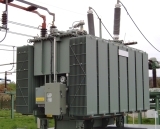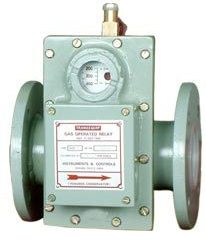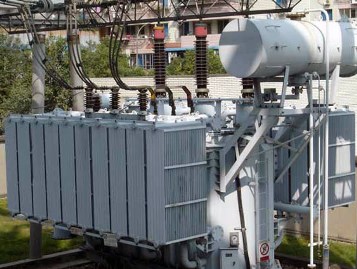Actions of the service personnel when the gas protection of the transformer is activated
 Failure of the power oil transformer in the tank is usually accompanied by outgassing. In this case, gas may be formed in case of decomposition of the transformer oil under the action of an electric arc or as a result of burning of the insulating materials of the windings. To protect the transformer from internal damage, a gas shield is used, which reacts to gases formed inside the tank.
Failure of the power oil transformer in the tank is usually accompanied by outgassing. In this case, gas may be formed in case of decomposition of the transformer oil under the action of an electric arc or as a result of burning of the insulating materials of the windings. To protect the transformer from internal damage, a gas shield is used, which reacts to gases formed inside the tank.
Gas protection — this is one of the main protections of a power transformer. Structurally, it is a gas relay located in the oil line of the transformer — that is, between the tank and the expander.
The operating personnel who serve the substation must know how to react properly in case of interruption of the transformer gas protection. To do this, you must first know the principle of operation. gas relay.
The gas relay has two floats, each connected to a corresponding pair of contacts.In normal operation of the transformer, the gas relay housing is completely filled with transformer oil, the floats are in their original position and the relay contacts are open. In case of failure, some gas will form inside the power transformer tank.
The gas relay is installed in such a way that the gas formed in the tank goes to the relay and accumulates in its upper part. The gas entering the gas relay gradually displaces the oil. One of the floats begins to sink downward under the influence of gravity. When the float reaches a certain position, the first group of contacts closes and transformer gas protection acts «on signal».

If the amount of gases formed is large and all the oil is displaced from the gas relay, the second float is lowered, which closes the group of contacts, which signals the power transformer to turn off.
In addition, a plate is provided in the gas relay that responds to the oil flow rate. Thus, in the event of internal damage to the transformer, which is accompanied by the occurrence of a flow of oil from the tank to the expander, the plate responds to the speed of this flow and, when a certain value is reached, acts to rotate outside the transformer.
Let's go directly to the consideration of actions of service personnel in case of gas protection of a power transformer.
In the general substation control center (control panel) there are panels for protection of substation equipment, including panels for protection of power transformers.The devices that perform the protection and automation functions of a power transformer can be electromagnetic (old style) or microprocessor based.
On the protective panels made on electromagnetic relays, there are special indicator relays — "blinkers" that show the operation of one or another protection of the transformer. That is, when the gas protection is triggered "on signal", a signal falls on the corresponding relay of the indicator.
If the gas protection works for shutdown, then on the protection panel of the transformer there is a signal not only about the operation of the gas protection, but also about the automatic shutdown of the transformer from all sides, as well as about the operation of automatic devices, in particular, automatically inclusion of reserve. In this case, an audible alarm is activated on the central alarm panel and the corresponding alarm elements light up.
If the protection and automation of the transformer are carried out on the microprocessor terminals of the protections, then the signaling of the operation of the protections and automation, in particular the gas relay and the automatic transfer switch, can be recorded by the illuminated LEDs on the terminals of the transformer protection and the central signaling on the control panel.
When the gas relay is activated, the signal, the service personnel who maintain this electrical installation must report the incident to the higher operating personnel - the duty dispatcher. According to the instructions of the latter, it is necessary to transfer the load and disconnect the transformer on which the relay tripped to another power transformer for further oil withdrawal from the gas relay.
In addition, the operating personnel inspects the power transformer for external damage to the structural elements.
Checking and selecting gas from the gas relay is done in accordance with EEBI rules and only after disconnecting and earthing the transformer from all sides from which voltage can be applied.
Switching on a transformer taken out for repair can be done only after gas analysis, transformer inspection and electrical laboratory tests and measurements of electrical parameters.
In some cases, when the interruption of the transformer led to the disconnection of the most important consumers (consumers of the first category, children's institutions, hospitals), the transformer can be put into operation until the reasons for the operation of the gas relay are fully clarified. In this case, permission to put the transformer into operation is given by the management of the enterprise, provided that there is no external damage to the transformer, as well as the incombustibility of the gas taken from the gas relay.
In case of disconnection of the gas protection, disconnect the power transformer, automatic inclusion of backup works. In this case, the transformer is switched off on all sides by the action of the gas protection and the ATS device supplies the deaerated sections (systems) of the busbars from another working power transformer.
The actions of the service personnel, as in the previous case, are reduced to closing the power transformer for repair for its inspection, gas extraction from the relay and electrical tests.
There are times when, for one reason or another, when the power transformer is disconnected from the gas protection, the ATS does not work.This leads to the fact that the bus sections supplied by the switched-off transformer lose voltage. In this case, it is necessary to manually power the disabled sections after making sure that these operations can be performed.
It should be noted that all the actions of the operational staff must be recorded in the operational and technical documentation of the serviced facility, in particular in the operational log and equipment defect log. The operational staff notifies the senior management and the dispatcher on duty of all incidents, according to whose instructions all further actions are taken to eliminate the accident.
That is, in this case, the management of the elimination of the accident is entrusted to the dispatcher on duty, but in the absence of communication with the dispatcher, the emergency response, including decision-making, is carried out by the operational personnel.
Therefore, the main task of operational personnel is the knowledge and ability to act in practice in the event of an emergency. In addition, there is a possibility that the dispatcher will give the wrong command, which can lead to negative consequences. Therefore, operational personnel must be able to analyze the situation and, if necessary, inform the dispatcher of possible operational errors.

